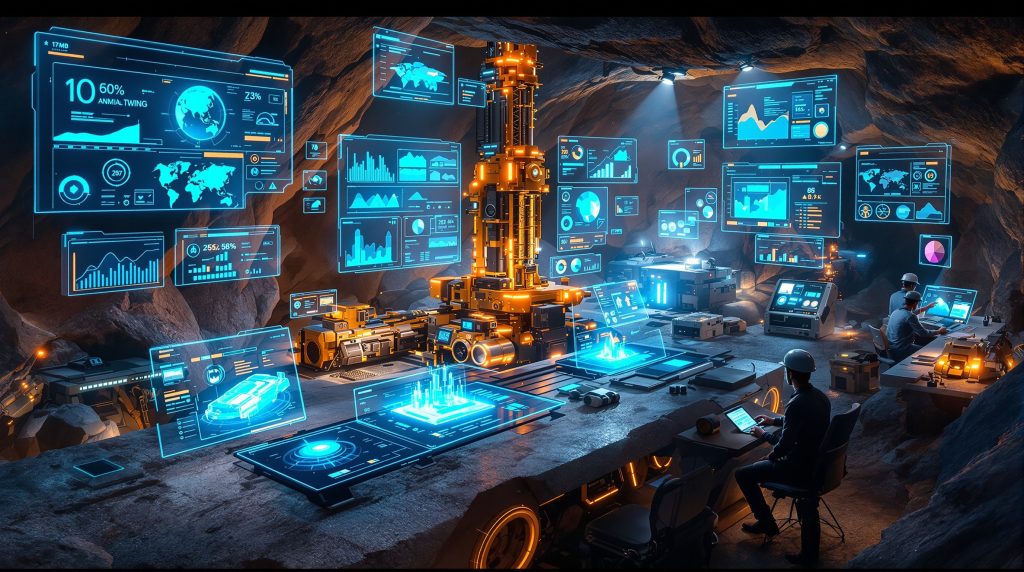The Evolution of Agentic AI in Mining Operations
The mining industry stands at a critical technological inflection point where intelligent systems are transforming from optional enhancements to strategic necessities. While traditional artificial intelligence has focused primarily on data analysis, agentic AI in mining represents a fundamental shift toward autonomous systems capable of independent decision-making, strategic planning, and continuous adaptation across mining operations.
Agentic AI differs from conventional automation by actively pursuing goals, engaging with multiple systems, and making complex decisions without constant human oversight. These capabilities are revolutionizing how mining companies approach exploration, extraction, processing, and environmental management.
Understanding the Shift from Traditional AI to Agentic Systems
Traditional AI systems in mining have typically been limited to specific functions like data processing or basic automation. These systems excel at analyzing historical information but lack the ability to make independent decisions or adapt to changing conditions without human intervention.
Agentic AI systems, by contrast, possess decision-making autonomy that allows them to evaluate situations, determine optimal responses, and implement solutions without waiting for operator approval. This represents a fundamental evolution in mining industry innovation —from tools that simply assist human operators to intelligent systems that can independently manage complex operations.
The mining sector has historically been cautious about adopting new technologies, preferring incremental improvements to radical transformation. However, the competitive advantages offered by agentic AI are becoming too significant to ignore, pushing even conservative operations to reconsider their technological approach.
According to Joseph Starwood, Global Mining Expert at Microsoft, "Artificial intelligence is an imperative, not an option! AI heralds a transformative era for the mining industry within the next decade." This sentiment reflects the growing consensus that mining companies must embrace intelligent systems to remain competitive.
What Makes Agentic AI Different from Traditional Mining Technology?
Autonomous Decision-Making Capabilities
The most significant difference between agentic AI and traditional mining technologies is the level of autonomy in decision-making. Conventional systems detect issues and alert human operators, who must then determine the appropriate response. This introduces delays and relies heavily on operator experience and availability.
Agentic systems, however, can independently:
- Detect equipment anomalies through sensor networks
- Analyze the severity based on historical and contextual data
- Evaluate multiple possible solutions against defined parameters
- Implement the optimal resolution without human intervention
- Document the incident, actions taken, and outcomes
- Incorporate the experience into future decision-making
This capability transforms how mining operations handle everything from equipment maintenance to emergency responses, significantly reducing downtime and improving overall efficiency.
Real-Time Adaptation and Learning
Unlike static systems that require reprogramming to handle new situations, agentic AI continuously learns and adapts based on operational data. This creates several key advantages:
- Processes become increasingly efficient as the system identifies optimization opportunities
- Equipment performance improves through adaptive operating parameters
- Geological models update in real-time based on extraction data
- Environmental management adapts to changing conditions
- Institutional knowledge is preserved and enhanced rather than lost with staff turnover
Shaun Mitchell, CEO of mining data solutions company MaxMine, notes that "From monitoring and scheduling maintenance to enhancing decision making, agentic AI is poised to play a transformational role in the future of mining."
Integration Across the Mining Value Chain
Traditional mining technologies typically operate in functional silos, with separate systems for exploration, extraction, processing, and logistics. This fragmentation limits efficiency and creates information bottlenecks.
Agentic AI systems excel at integrating across the entire mining value chain, creating a unified operational ecosystem. This holistic approach enables data-driven operations throughout the mining process, connecting previously isolated systems and information flows.
| Mining Function | Agentic AI Integration Benefits |
|---|---|
| Exploration | Dynamic geological modeling that incorporates real-time drilling data |
| Extraction | Coordinated equipment deployment based on changing priorities |
| Processing | Continuous optimization of mineral recovery parameters |
| Logistics | Predictive supply chain management with adaptive routing |
| Maintenance | Preemptive equipment servicing based on operational patterns |
| Reclamation | Data-driven environmental restoration planning |
This integration eliminates operational silos and creates a connected ecosystem where decisions in one area account for impacts across the entire operation.
How is Agentic AI Improving Mining Safety?
24/7 Monitoring and Intervention
Safety represents one of the most compelling applications for agentic AI in mining operations. These systems maintain constant vigilance across all operational areas through:
- Comprehensive sensor networks monitoring environmental conditions
- Computer vision systems tracking equipment and personnel movements
- Integration of wearable safety devices with central monitoring
- Real-time risk assessment based on changing conditions
- Automatic intervention when unsafe situations develop
Futurist Ian Khan emphasizes that "In mining, agentic AI can deliver 24/7 dynamic safety monitoring and intervention," highlighting how these systems can transform workplace safety through constant vigilance and rapid response capabilities.
Unlike human supervisors who may experience fatigue or attention lapses, AI monitoring systems maintain consistent alertness, potentially identifying hazards before they escalate into dangerous situations.
Removing Humans from Hazardous Environments
Perhaps the most significant safety benefit comes from agentic AI's ability to manage operations in dangerous environments without human presence. This includes:
- Deep underground mining areas with unstable ground conditions
- Locations with poor air quality or toxic gas risks
- Extreme temperature environments that pose health risks
- High-risk AI in drilling & blasting zones
- Underwater or high-pressure extraction operations
By replacing human workers in these high-risk areas with AI-controlled equipment, mining companies can dramatically reduce workplace injuries and fatalities while maintaining productivity levels.
The progression toward fully autonomous mining operations represents a paradigm shift in how the industry approaches worker safety—eliminating risk by removing humans from dangerous environments entirely.
Predictive Risk Assessment
Beyond monitoring current conditions, agentic AI excels at predicting potential safety issues before they manifest, creating opportunities for preventive intervention:
- Analysis of historical incident data reveals patterns that precede accidents
- Equipment performance metrics indicate potential failure points
- Environmental monitoring identifies changing conditions that increase risk
- Worker behavior analysis highlights practices that could lead to injuries
- Integration of weather forecasts with operational planning
This predictive capability transforms safety management from reactive to proactive, potentially preventing accidents rather than simply responding to them after they occur.
What Operational Efficiencies Does Agentic AI Deliver?
Fleet Optimization and Maintenance
Mining equipment represents one of the industry's largest capital investments, and maximizing equipment efficiency directly impacts operational profitability. Agentic AI delivers significant improvements through:
- Optimal routing of mobile equipment to minimize travel time and fuel consumption
- Predictive maintenance scheduling based on actual usage and performance data
- Dynamic reallocation of equipment based on changing operational priorities
- Tire wear reduction through path optimization and operating parameter adjustments
- Extended equipment lifespan through optimized usage patterns
Industry experts suggest that AI-driven fleet optimization can reduce operational costs by 15-20% while extending equipment lifespan by up to 30%, representing significant financial benefits for mining operations.
Energy Efficiency Improvements
Energy consumption represents both a major operational cost and a significant environmental impact for mining operations. Agentic AI addresses this challenge by:
- Optimizing crushing and grinding operations for minimal energy use
- Scheduling energy-intensive processes during off-peak rate periods
- Integrating renewable energy sources with operational planning
- Identifying and eliminating energy waste across operations
- Balancing production requirements with energy availability
These optimizations can reduce energy consumption by 10-15% in large mining operations, representing millions in cost savings while also reducing environmental impact.
Wicus Burger, Managing Director of Komatsu Africa, confirms this potential, stating that "Our customers will benefit through improved platforms, modernised user interfaces and enhanced lifespan of equipment" through their strategic partnership with Applied Intuition.
Production Optimization
Agentic AI systems excel at balancing the complex variables that affect mining production efficiency:
- Ore grade optimization maximizes valuable mineral recovery
- Blending strategies maintain consistent processing characteristics
- Throughput optimization prevents bottlenecks in the production chain
- Recovery rate improvements come through adaptive processing parameters
- Quality control becomes more consistent through real-time monitoring
By continuously adjusting these parameters in response to changing conditions, agentic AI helps mining operations achieve higher recovery rates with lower operational costs.
What Strategic Advantages Does Agentic AI Provide?
Competitive Differentiation
Mining companies that successfully implement agentic AI gain significant competitive advantages:
- Lower operational costs translate to better profit margins
- Enhanced safety performance improves regulatory standing
- Greater operational flexibility allows faster adaptation to market changes
- Improved environmental performance strengthens social license to operate
- More predictable production reduces market volatility
These advantages become increasingly important in a global mining industry characterized by tightening margins and growing regulatory scrutiny.
Investment Attraction
The mining sector competes globally for investment capital, and technological leadership has become an important factor in investment decisions. Mining operations with agentic AI implementation demonstrate:
- Commitment to operational excellence through technology adoption
- Reduced operational risks through enhanced predictability
- Improved sustainability metrics attractive to ESG-focused investors
- Higher potential returns through operational efficiency
- Longer projected operational lifespans for mining assets
These factors can make AI-enhanced operations more attractive to investors seeking both financial returns and sustainability credentials.
Future-Proofing Operations
Mining operations typically have long operational lifespans, making forward-looking technological investments essential. Early adoption of agentic AI helps ensure long-term viability through:
- Continuous evolution of capabilities as technology advances
- Workforce development focused on high-value oversight roles
- Adaptability to increasingly stringent environmental regulations
- Enhanced competitiveness even as resource quality declines
- Improved ability to operate in challenging environments
Akash Singh, Principal IT Architect at Boston Consulting Group, emphasizes that "Agentic AI is not just the next wave of technology; it is mining's strategic reset. While Africa has yet to scale autonomous ecosystems, the chance to leapfrog is enormous."
What Implementation Challenges Must Be Addressed?
Infrastructure Requirements
Successful implementation of agentic AI systems requires robust supporting infrastructure that may not be present at many mining sites:
- High-bandwidth connectivity throughout operational areas
- Edge computing capabilities for real-time processing
- Comprehensive sensor networks covering all critical equipment
- Reliable power sources for continuous operation
- Redundant systems to ensure operational continuity
For remote mining operations, these infrastructure requirements present significant challenges and costs that must be addressed before agentic AI can be fully implemented.
Data Quality and Integration
The effectiveness of any AI system depends entirely on the quality of data it receives, presenting several challenges:
- Historical operational data often requires extensive cleaning and normalization
- Legacy systems frequently use incompatible data formats
- Sensor networks must be properly calibrated and maintained
- Data governance frameworks must ensure accuracy and accessibility
- Real-time integration capabilities may require significant system upgrades
Addressing these data challenges often represents the most time-consuming aspect of agentic AI implementation, requiring both technical solutions and organizational changes.
Workforce Transition
Perhaps the most challenging aspect of implementing agentic AI is the necessary workforce transition:
- New roles emerge focused on AI oversight rather than direct operation
- Training programs must develop AI management skills in existing personnel
- Cultural shifts are required to embrace technology-assisted decision-making
- Knowledge transfer from experienced operators to AI systems becomes critical
- Resistance to change must be addressed through clear communication
As Ian Khan notes, "This is not just about tools. It is about mindset. Mining leaders must act now." This emphasizes the importance of addressing the mining workforce challenges when implementing technological transformation.
Governance and Oversight
As mining operations become increasingly dependent on agentic AI, governance becomes a critical concern:
- Clear accountability frameworks must be established for AI-driven decisions
- Transparency requirements ensure system operations can be audited
- Regular performance and safety auditing becomes essential
- Regulatory compliance verification must be built into system design
- Ethical guidelines for autonomous systems must be developed
Joseph Starwood of Microsoft highlights this need, noting that "Board members must extend the same level of oversight and governance to AI management as they do to other corporate matters."
How Will Agentic AI Shape Mining's Future?
Emergence of Fully Autonomous Mining
The ultimate evolution of agentic AI in mining is the fully autonomous operation:
- Integrated systems managing all aspects from exploration through reclamation
- Minimal on-site human presence except for oversight roles
- Continuous optimization across all operational parameters
- Real-time adaptation to changing conditions without human intervention
- Remote operation centers managing multiple mining sites simultaneously
While fully autonomous mining remains aspirational for most operations, partial implementation is already occurring at advanced mining sites worldwide, with incremental steps toward complete autonomy.
Enhanced Sustainability Through Intelligence
Agentic AI will play a crucial role in improving mining's environmental performance:
- Precise extraction minimizes waste material production
- Optimized water and energy usage reduces resource consumption
- Reduced land disturbance through targeted operations
- Improved reclamation through data-driven approaches
- Enhanced monitoring of environmental impacts
These improvements address growing regulatory requirements and societal expectations for more sustainable mining practices, potentially transforming the industry's environmental reputation.
Collaborative Industry Ecosystems
As agentic AI becomes standard in mining operations, industry collaboration will increase:
- Shared data platforms improve system learning across operations
- Industry standards emerge for AI implementation and governance
- Collaborative research and development reduces implementation costs
- Supply chain integration through compatible AI systems improves efficiency
- Best practices spread more rapidly through industry networks
This collaboration has the potential to accelerate the industry's technological transformation while reducing implementation risks and costs.
What Actions Should Mining Leaders Take Now?
Strategic Assessment and Planning
Mining executives should prioritize comprehensive evaluation of their current technological position:
- Assess current technological capabilities against industry benchmarks
- Identify high-impact implementation opportunities specific to their operations
- Develop phased implementation strategies with clear milestones
- Create governance frameworks for AI oversight and evaluation
- Establish metrics to measure implementation success and ROI
This strategic approach ensures that agentic AI implementation aligns with business objectives and delivers measurable value.
Investment in Foundational Capabilities
Successful agentic AI implementation requires investment in several foundational capabilities:
- Data infrastructure development and standardization
- Workforce training and cultural preparation
- Partnerships with technology providers and research institutions
- Pilot projects to demonstrate value and refine approaches
- Communications strategies to address stakeholder concerns
These investments create the necessary foundation for successful implementation while managing technical and organizational risks.
Regulatory Engagement
As agentic AI transforms mining operations, regulatory frameworks must evolve:
- Proactive engagement with regulators helps shape appropriate oversight
- Development of industry best practices guides regulatory approaches
- Transparent reporting on AI performance builds regulatory confidence
- Collaborative approaches address emerging regulatory challenges
- Early adopters gain opportunities to influence regulatory direction
This engagement ensures that regulatory frameworks evolve in ways that both protect the public interest and enable technological innovation.
The Imperative for Action
The mining industry stands at a technological inflection point where agentic AI represents not just an opportunity but a necessity for future competitiveness. Those who embrace this transformation will define the next era of mining, while those who hesitate risk being left behind in an increasingly technology-driven industry.
As Pascal Bornet, Author of Agentic Artificial Intelligence, explains: "The printing press democratised knowledge. The internet connected humanity. AI, in its agentic form, has the potential to amplify human capabilities in ways that we are only beginning to comprehend."
The question is no longer if mining will be transformed by agentic AI, but how quickly leaders are willing to act to secure their place in this new technological landscape. With Mining Indaba 2026 set to focus heavily on AI transformation, industry leaders have a perfect opportunity to engage with this technology and chart their course toward an AI-enhanced future through modern mine planning.
Disclaimer: This article contains forward-looking statements about the potential impact of agentic AI on the mining industry. These predictions are based on current technological trends and expert opinions but represent speculative projections rather than guaranteed outcomes. Mining companies should conduct their own technological assessments before making investment decisions.
Ready to Spot the Next Major Mineral Discovery?
Discovery Alert's proprietary Discovery IQ model instantly notifies investors when significant ASX mineral discoveries occur, turning complex mining data into actionable trading opportunities before the broader market reacts. Explore historic examples of exceptional returns on our dedicated discoveries page and begin your 30-day free trial today.




